Punch Buggy
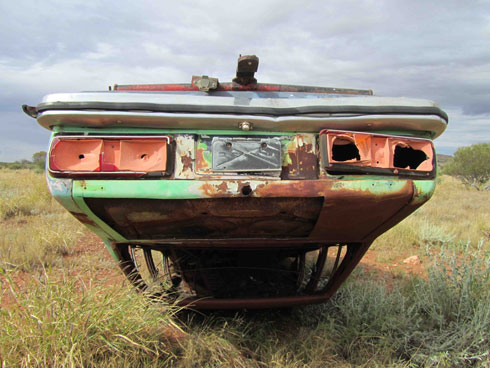
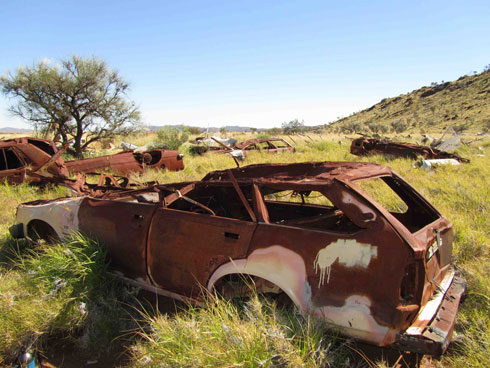
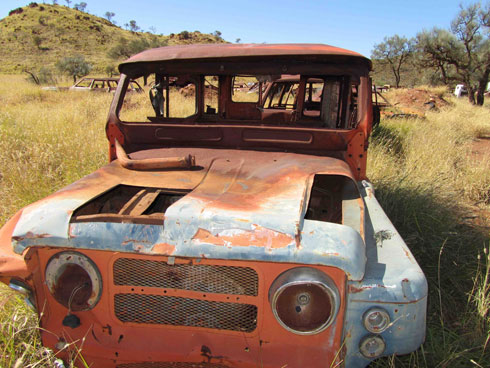
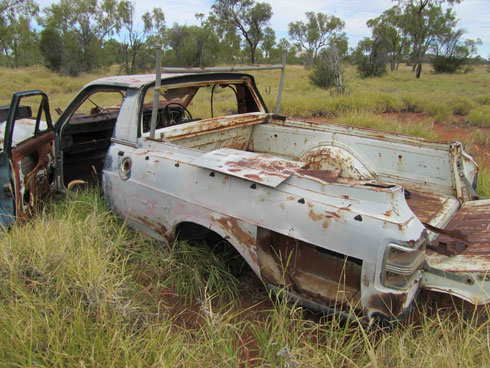
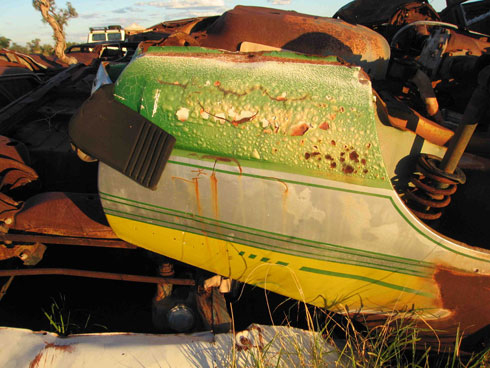
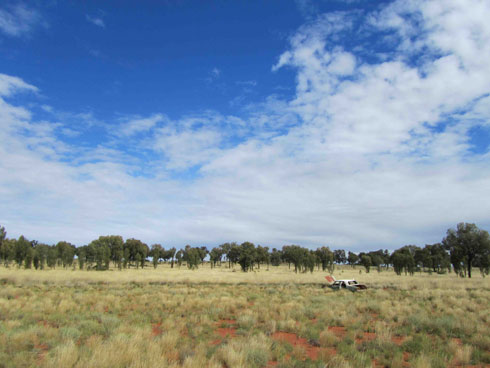 Text: Sunday Ganim Images: Saskia Folk
Text: Sunday Ganim Images: Saskia Folk
Melbourne native Saskia Folk, is a hunter and gatherer of metalwork stripped from cars in the central desert of Australia, and is not to be mistaken for a rev-head. Sunday Ganim catches up with her to talk about her new works in the lead up to her upcoming show Panel Work at Scott Livesey Galleries, Melbourne.
Sunday Ganim: I know you were living up out of Alice Springs leading up to the creation of this series, how did you come to be up there?
Saskia Folk: I travelled through the centre back in 2000 and yearned to return with a purpose. I was familiar with community life but wanted to experience it for myself and learn more about Aboriginal Art. Papunya Tula Artists founded the Western Desert Art movement and is held in high regard. So I approached them with my resume, met the manager and the rest is history.
SG: Where were you based?
SF: I would go out bush for two weeks and then come back and spend a week in the gallery in town. Most of my time was spent between Kintore (530km west of Alice) and Kiwirrkura (770km west of Alice). In Alice I lived in a classic caravan in my mate’s backyard, in true trailer trash style! In Kintore we shared a house that was attached to the Art Centre, right in the heart of the community. And in Kiwirrkura, the most remote community in Australia the quietest, a simple demountable was an ample dwelling in the white fella end of town.
SG: What day-to-day things did you do for the Papunya Tula artists when you were there?
SF: I made a lot of cups of tea, stretched canvas, mixed paints, transcribed the stories behind the paintings, wrote a heap of cheques, tended to the needs of the Elders and their families, joked around and ran around like a headless chook.
SG: What got you interested in the abandoned cars?
SF: In our spare time at Papunya Tula we would rummage the tips in search of treasure. Initially I found metal objects, pilfered car badges and reworked them into art. Another Papunya Tula worker and I made a fence out of car bonnets, to create some privacy for our yard and it all evolved from there.
SG: Tell me about your process, how do you tackle cutting the panels from the cars in the desert?
SF: Initially I used a hacksaw, but it was tough going… There was a car door that I was determined to remove that nearly broke me. I tried every means to remove it with no luck. That’s when I decided to get a cordless angle grinder. It does the job but the batteries run out quick. With four batteries I get about two hours of cutting. Then I would cart them back to Alice and clean them up and fine tune the size and shape that I wanted.
SG: What are you drawn to in each panel that you choose to cut out – is it the colour, wear, dents, rust, shape, the firebombing?
SF: There has to be some kind of variation in the panel. Each panel I select must have at least one of the characteristics you have mentioned. I am not interested in flat colour or new shiny paint jobs. The process of deterioration is what fascinates me.
SG: The long exposure to the elements seems to play such a large part in shaping the changes in these cars, are you amazed by the force of nature and the effects it has on the cars?
SF: Totally. The desert is quite unique in that respect. In wetter parts of Australia the vehicles would be totally devoid of character. But here in the desert the process slows dramatically, the colours fade and crack differently and rust is slower to take over. The side of the car most exposed to the elements may be completely rusted out, but walk around it and find bursts of colour and texture.
SG: Where do you find these cars, do they find you?
SF: They are scattered all over the desert. I would drive 1400km a fortnight for work along a dusty road and see them pop up over the horizon. If I saw one I like the look of I’d get out of the car and walk around it, inspecting every piece of it. We would go out hunting on the weekends and come across them, I guess while mob were looking for goanna, I was looking for cars. The communities would house graveyards of abandoned cars. They weren’t that hard to find but the good ones worthy of removing a panel were diamonds in the rough. Kind of like a game of punch buggy.
SG: I know that some of these cars have been there for a few decades. Do you see the cars as an extension of the landscape?
SF: The cars are part of the landscape and reflect the history. Aboriginal people have inhabited the land out there for 40,000 years, they left their mark on the land with carvings. The cars left out there reflect a history of the last 60 years, where they went, in what cars (particularly Holden’s and Ford’s), who owned them and so on.
SG: Does driving around in the desert finding the panels, affect your connection to the landscape?
SF: I keep falling in love with it more. It’s hard to describe my connection to the desert. It is an amazing place that is constantly changing in the most subtle ways. I get excited being on the open road, it’s an adventure and finding panels is part of it. Now that I am going further afield, I am discovering new places and marvelling at how much the landscape varies.
SG: One thing I notice about you, is that you are always drawn to people, interesting people or stories that people have, are you attracted to these vehicles in a similar way – if the car has an interesting story behind it does that make you seek out a panel from it?
SF: There are certain cars I won’t touch, especially ones with graffiti on them. They are iconic landmarks. There is a classic one where one car is on top of another and sprayed on it is “to cars bin puckin” (two cars been fucking). Cars like that or really old amazing ones I just photograph instead.
SG: You’re a trained photographer, is the photographers instinct for a good shot, the same as the feeling you get in your gut when you find just the right panel?
SF: Nah it’s even better… For me finding panels is like a scavenger hunt, you get that giddy feeling when you find the treasure.
SG: I find it interesting that these cars are driven until they basically stop running, then are abandoned and left to deteriorate. Then you come along and begin your work with something that has been deemed as rubbish. For as long as I’ve known you, you have always created things from second hand and used stuff, what attracts you to the idea of generating something fresh from something discarded?
SF: I like the challenge. Plus out in the desert you don’t have much choice, there aren’t any art shops to buy materials, so it forces you to be resourceful. I get more satisfaction in finding the beauty in something someone else sees as junk and reworking it into a new form.
SG: Also, a while back we talked once about the way in which the aboriginal people view the landscape, particularly the ground, to see what animal tracks were around. Then later we watched a doco and there was an aboriginal man saying he remembered seeing the first car tracks on the ground and how seeing these continuous tracks really blew his mind – is that something you ever think about when cutting the panels?
SF: Anangu taught me how to look at the ground around me to decipher what animals are around. It is their primary hunting technique. Because a majority of the ground is sand it is possible to track an animal by following the marks it makes when it moves. When Aboriginals saw car tracks for the first time they couldn’t work out what it was. It’s hard to imagine. When I get out of my car to check something out or even just have a pee I check the ground for markings. Then at least you know if there is a snake around!
SG: Any good car stories?
SF: Shit. Where to begin. In the two years I was out in the desert I saw some classic stuff. Guys driving around in cars that you would have given up on years ago blaring the same song over and over, beaten up beyond repair. Cars jammed packed with people, 14 was my record. I got bogged sideways with two wheels in the air and had to ditch the car. Helped so many people out of hairy situations in the middle of nowhere. I could go on for ages.
Panel Work opens on Friday August 12 at Scott Livesey Galleries, Melbourne
Saskia Folk
Next story: Henge Beat – Total Control



